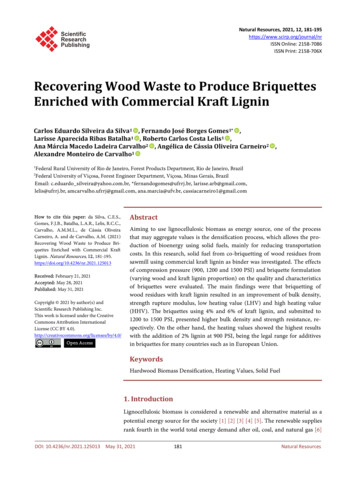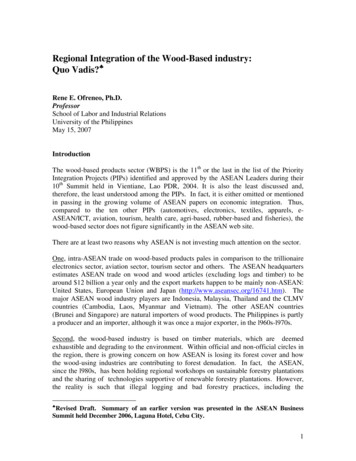
Transcription
Natural Resources, 2021, 12, 181-195https://www.scirp.org/journal/nrISSN Online: 2158-7086ISSN Print: 2158-706XRecovering Wood Waste to Produce BriquettesEnriched with Commercial Kraft LigninCarlos Eduardo Silveira da Silva1 , Fernando José Borges Gomes1* ,Larisse Aparecida Ribas Batalha1 , Roberto Carlos Costa Lelis1 ,Ana Márcia Macedo Ladeira Carvalho2 , Angélica de Cássia Oliveira Carneiro2 ,Alexandre Monteiro de Carvalho1Federal Rural University of Rio de Janeiro, Forest Products Department, Rio de Janeiro, BrazilFederal University of Viçosa, Forest Engineer Department, Viçosa, Minas Gerais, Brazil12How to cite this paper: da Silva, C.E.S.,Gomes, F.J.B., Batalha, L.A.R., Lelis, R.C.C.,Carvalho, A.M.M.L., de Cássia OliveiraCarneiro, A. and de Carvalho, A.M. (2021)Recovering Wood Waste to Produce Briquettes Enriched with Commercial KraftLignin. Natural Resources, 12, ived: February 21, 2021Accepted: May 28, 2021Published: May 31, 2021Copyright 2021 by author(s) andScientific Research Publishing Inc.This work is licensed under the CreativeCommons Attribution InternationalLicense (CC BY en AccessAbstractAiming to use lignocellulosic biomass as energy source, one of the processthat may aggregate values is the densification process, which allows the production of bioenergy using solid fuels, mainly for reducing transportationcosts. In this research, solid fuel from co-briquetting of wood residues fromsawmill using commercial kraft lignin as binder was investigated. The effectsof compression pressure (900, 1200 and 1500 PSI) and briquette formulation(varying wood and kraft lignin proportion) on the quality and characteristicsof briquettes were evaluated. The main findings were that briquetting ofwood residues with kraft lignin resulted in an improvement of bulk density,strength rupture modulus, low heating value (LHV) and high heating value(HHV). The briquettes using 4% and 6% of kraft lignin, and submitted to1200 to 1500 PSI, presented higher bulk density and strength resistance, respectively. On the other hand, the heating values showed the highest resultswith the addition of 2% lignin at 900 PSI, being the legal range for additivesin briquettes for many countries such as in European Union.KeywordsHardwood Biomass Densification, Heating Values, Solid Fuel1. IntroductionLignocellulosic biomass is considered a renewable and alternative material as apotential energy source for the society [1] [2] [3] [4] [5]. The renewable suppliesrank fourth in the world total energy demand after oil, coal, and natural gas [6]DOI: 10.4236/nr.2021.125013 May 31, 2021181Natural Resources
C. E. S. da Silva et al.[7], being biomass the most significant type of renewable supply and due to itsadvantages of being widely sourced, sustainable, and environmentally friendly, ithas attracted more and more interest of academic and industrial sectors [8].Considering the concerns on the rational utilization of the lignocellulosic biomass by our society, wood processed in the sawmills, which is a common activityin many countries, is another neglected raw material, since it is available in alarge volume. In these activities, the wood is poorly used, with around 40% 60% of waste being generated from the log wood processing [9], which in general is burned in the sawmills to generate energy or discarded into landfills [10].A challenge for using waste lignocellulosic biomass is that it must be transported from where they are generated, often in milling sites and open fields, tothe storage facilities, which may affect the energy balance and costs [11] [12][13] [14] [15]. One effective strategy to address these concerns is through mechanical densification of the biomass. Mechanical densification is the compaction of biomass to definite sizes, which improves the bulk densities and minimizes the irregularities in shape of biomass, facilitating the transportation [16].In lignocellulosic biomass processing for the production of solid fuel, pelletizersand briquette press are the most commonly used equipment for mechanicaldensification. These solid fuels are frequently used as substitute fuels in boilersto produce steam that may be used for electricity production, for example.Kaliyan & Morey [16] and Ajiboye et al. [17] support that as a result of theshape and size, among other variables, can determine the compressibility and theproducts of the densification. Briquettes with higher density values, producedfrom agriculture and forest residue, may substitute or compliment solid fuelssuch as charcoal, firewood and coal. The briquettes are high energy density materials, require lower transportation and storage costs, present uniform qualitysuch as constant humidity content, and high mass fluency [18] [19].Several studies have experimentally investigated the characteristics of alternative biomass briquettes, as wood residues, under different conditions of pressure.The results show that the sawdust, most abundant waste or residue in wood-basedindustries [20], may generate briquette with better characteristics than othermaterials [21].Aiming to improve the mechanical and physico-chemical properties of thesolid fuel, many organic and inorganic binders may be used for the densificationprocess [22] [23] such as starch, protein, fiber, fat/oil, and other additives. Theaddition of binders in the densified solid fuel production using lignocellulosicbiomass as raw materials might have a positive outcome on the strength, in asimilar way to the resins used in the production of wood boards [24] [25].Considering the available materials from the based forest industry that couldbe used for bindering purpose, the kraft lignin appears as a promissory material,since it is a hydrophobic compound and it also presents a higher heating valuewhen compared to the whole lignocellulosic biomasses [26] [27] [28] [29] [30].The worldwide lignin production is approximately 50 million tons [31] and thisDOI: 10.4236/nr.2021.125013182Natural Resources
C. E. S. da Silva et al.by-product have distinct adhesive characteristics and may be used as a densification binder [29]. The use of lignin as binder is relatively new and studies of thisapplication as a binder have been done recently [28] [29] [32]-[38]. The resulting briquettes would cost less to transport, easier to handle and storage [39].Regarding the available lignocellulosic biomasses for being used as raw materials, the residual material of the industrial processes seems to be an alternativefor improving the rational utilization of the natural resources. Concerning thespecie of wood, Astronium concinnum (Engl.) Schott, a hardwood species, belongs to the family of Anacardiaceae, commonly known as gonçalo-alves, aroeira-rajada, guarubu-violeta and mucuri, which is a raw material widely usedcommercially due to its wood quality and availability [40]. Its wood is more usedin exteriors, buildings, floors and furniture [41] [42] [43] and its basic densityvalue is around 0.64 g/cm3 [44].The main goal of this research was to evaluate the application of commonwoody industrial waste from sawmills (sawdust of Astronium Concinnum(Engl.) Schott) enriched with eucalypt kraft lignin as an additive, aiming toproduce briquettes.2. Materials and Methods2.1. Raw MaterialsIn this work residues from the wood sawmill processing Astronium concinnum(Engl.) Schott were used. The wood samples evaluated were 37 years old. Threetrees samples were collected from an experimental station in the Vale NaturalReserve, which is inside the Atlantic Forest biome, located in Sooretama, Espírito Santo State, Brazil. The residues were obtained from a machining processcommonly used on a sawmill. The residues (sawdust) were collected and airdried to a moisture content of about 15% and stored in plastic bags. The commercial kraft lignin used as an additive in the briquetting process was obtainedfrom a Brazilian kraft pulp mill, Suzano Pulp and Paper, which uses Eucalyptusspp. as feedstock.2.2. MethodsThe wood biomass, commercial kraft lignin and briquettes were characterizedaccording to the methods described in Table 1.The briquetting process was conducted using a laboratory briquette machinewith a piston press (LB-32, Lippel, Brazil). The briquetting conditions were determined experimentally through preliminary tests of pressure application andthe time required for pressing and cooling. The temperature chosen (120 C) wasdetermined as a function of the lignin plasticization, which is a compound responsible for the bond among the wood particles during the application of pressure [59]. Three compression pressure conditions were used: 6.20 MPa (900PSI); 8.27 MPa (1200 PSI); and 10.30 MPa (1500 PSI), with pressing and coolingtimes of 6 minutes.DOI: 10.4236/nr.2021.125013183Natural Resources
C. E. S. da Silva et al.Table 1. Methods used to characterize wood biomass, kraft lignin and briquettes.AnalysisStandardSawdust fractionationTAPPI T257 cm-02 [45]ExtractivesTAPPI T264 cm-97 [46]AshesTAPPI T15 os-58 [47]; T211 [48]CarbohydratesWALLIS et al. [49]; SCAN-CM 71:09 [50]Soluble ligninTAPPI UM 250 [51]Insoluble ligninTAPPI T222 om-97 [52]Acetyl groupsSOLAR et al. [53]Uronic acidsSCOTT [54]Elemental analysis (CHNSO)DIN EN 15104 [55] which was measured by using aTruSpec Micro-Leco Instruments 628 Series C/H/Nelemental analyzer with oxygen and sulfur moduleLow and High Heating ValuesDIN EN 14918 [56]Briquettes bulk densityVITAL [57]Rupture Modulus of BriquettesNBR ISO 11093-9 [58]To determine the briquetting conditions, preliminary tests relating to compaction time, cooling time and temperature were carried out. The conditionschosen were those where briquettes were obtained without cracks and with lessdeformation. The working moisture was 8%, obtained by using a laboratorygreenhouse, which was within the ideal range proposed by Kaliyan and Morey[16]. The use of moisture higher than 8% would cause the briquettes to rupture.When the raw material moisture content is very dry or above the indicated value, it can impair the packaging of the material or produce an unstable briquette,which may disintegrate when stored or transported [60], resulting in lower durability and therefore becomes more susceptible to damage [61].The proportion of Kraft lignin mixed with the wood fines was 0%, 2%, 4%,and 6%, and the mass of each briquette was fixed to 20 g, amounting 12 treatments, with 6 repetitions of each one. When an excess of the kraft lignin is used,it loses its efficiency as a binding agent and it negatively affects the briquettedensity [38]. Preliminary tests were performed and no more than 6% of ligninwas used to avoid problems occurring with the equipment, relating to the ligninplasticization, and considering that just 2% of additives may be used in briquettes in many countries, for instance in European Union, the values above thisrange were used just for evaluating the potential performance delivered by theadditive. In order to evaluate the quality of the briquettes and the briquettingprocess, visual analyzes were first carried out to observe the presence of cracksand deformations on their sides, as well as analyzes of the variations of the dimensions (height and diameter) and loss of mass in the briquetting. These visualobservations were performed after the cooling time during measurements ofheight and diameter of briquettes.DOI: 10.4236/nr.2021.125013184Natural Resources
C. E. S. da Silva et al.Unfortunately, there was not found literature data which report on the rawmaterial investigated in this study. Therefore, several hardwood species wereused as a reference for comparing the results from this work. This also indicatesthat this work collaborates for disseminating some unpublished scientific information on the raw material used.Aiming to analyze results obtained in this work, the Shapiro & Wilk test wasused to verify the normality of the briquettes data [62]. The data were also submitted to analyses of variance using the Cochran test [63] to evaluate differencesamong treatments. The Tukey’s t-test was applied at a 95% significance level,when significant differences among the results were found.3. ResultsThe results on the wood residues and eucalypt kraft lignin composition are described in Table 2, taking into account the chemical composition importance ofthe materials for energy conversion. As also previously described, there was notfound literature data which report on the raw material investigated in this study,being the findings on the wood composition an important piece of informationfor many other works.Briquetting processTable 3 shows results relating to the briquetting processes on the bulk density,modulus of rupture (MOR) and heating values (LHV and HHV) of the studiedTable 2. Chemical characterization of the evaluated biomass and kraft lignin.AnalysisAstronium concinnum biomassKraft 34.20Soluble extractives, %6.2-Soluble lignin, %3.84.5Insoluble lignin, %19.880.9Total lignin, inan0.20.1Galactan0.70.1Ash, %0.714.2High heating value, MJ/kg19.021.7Low heating value, MJ/kg17.720.8Elemental analysis, %Carbohydrates, %DOI: 10.4236/nr.2021.125013185Natural Resources
C. E. S. da Silva et al.Table 3. Mean values of briquettes bulk density (ρap), modulus of rupture (MOR) andheating values (LHV and HHV) per treatment.Treatmentsρ ap (g/cm3)MOR (kgf/cm2)LHV (MJ/kg)HHV (MJ/kg)T11.01 0.01f10.7 13.6cd16.3 0.00e18.2 0.00eT21.00 0.04fg9.2 14cd16.3 0.00e18.2 0.00eT31.03 0.03e9.1 12.7cd16.2 0.00f18.1 0.00fA11.08 0.01d26.3 10.3c16.9 0.00a18.8 0.00aA21.11 0.01c25.1 10.3c16.6 0.01cd18.4 0.05dA31.13 0.01b22.2 9.9cd16.7 0.00c18.5 0.05bcB11.13 0.03ab30.6 7.9c16.8 0.00b18.7 0.00bB21.16 0.02a39.7 5.7b16.7 0.00c18.6 0.00cdB31.16 0.01a37.3 5.8b16.7 0.00c18.6 0.00cdC11.16 0.01a51.4 4.6a16.9 0.01ab18.7 0.05abC21.16 0.02a45.6 3.5ab16.3 0.01ef18.5 0.05cC31.16 0.01a43.0 1.4b16.3 0.00e18.1 0.05efNote: (T1) pressure 900 PSI; (T2) pressure 1200 PSI; (T3) pressure 1500 PSI; (A1) 2% Kraft lignin samplewith 900 PSI; (A2) 2% Kraft lignin sample with 1200 PSI; (A3) 2% Kraft lignin sample with 1500 PSI; (B1)4% Kraft lignin sample with 900 PSI; (B2) 4% Kraft lignin sample with 1200 PSI; (B3) 4% Kraft lignin sample with 1500 PSI; (C1) 6% Kraft lignin sample with 900 PSI; (C2) 6% Kraft lignin sample with 1200 PSI;(C3) 6% Kraft lignin sample with 1500 PSI. Equal letters in the same column indicate equality between thevalues of the averages at a significance level of 95%.briquettes. These results are considered important parameters for the quality ofthe briquettes.The modulus of rupture result was determined using software coupled withthe universal test equipment called “Contenco-Pavitest”. The analysis procedurewas in accordance with the Brazilian standard NBR ISO 11093-9 [58] withadaptations. The equipment applies a perpendicular force on the upper side ofthe briquette through a piston until it ruptures. The force was determined by apreliminary test speed (3.5 mm min 1). The briquette was tested in the verticalposition, and the forces were applied parallelly, according to methodology adaptedfrom the ABNT NBR ISO 11093-9 standard [58].As expected, the bulk density increased, due to the agglutination and plasticization of lignin. The produced briquettes with 4% and 6%, respectively treatments B and C, of incorporated Kraft lignin did not show difference related tothe bulk density. However, these treatments showed difference in treatments T(0% KL) and A (2% KL). In general, the use of additives in briquettes are limitedto two percent, but this study showed that the inclusion of 4% and 6% of KLcontributed to the increase in the bulk density, also 4% and 6% (at 900 PSI) presented significant increase in the rupture modulus of the briquettes (Figure 1).On the other hand, the decrease of the rupture modulus in treatments C2 andC3 was observed, and it can be explained by cohesion strength among the particles with higher pressure due to the chemical composition of wood biomassDOI: 10.4236/nr.2021.125013186Natural Resources
C. E. S. da Silva et al.(a)(b)Figure 1. Properties of the briquettes, being: (a) bulk density; (b) modulus of rupture.(a)(b)Figure 2. Astronium concinnum briquettes heating values using different concentrations of kraft lignin (KL) as additive, being (a)low heating value; (b) high heating value.and the kraft lignin used, which possess lower content of lignin and a significantpercentage of ashes on its composition, which may affect the binder process.Analyzing the values shown in Table 3 and Figure 2 is possible to affirm thatthe briquettes produced in 900 PSI showed higher heating values. The lowestheating value (LHV) was obtained when using 0% KL at higher pressure values(1500 PSI). The briquettes produced with 2% KL presented the highest HHV,followed by the 4% KL and 6% KL, respectively.4. DiscussionThe elemental analysis is a factor that depends on comparison age due to anatomical and structural changes that happen inside the biomass. It was possible toobserve that wood biomass evaluated (Astronium concinnum) in this researchpresented similar percentage of carbon (46.0% - 49.95%), hydrogen (4.8% 6.2%), nitrogen (0.1% - 2.4%), oxygen (43.1% - 46.7%), and sulfur (0.01% 0.05%) when compared to the other commercial woods such as Eucalyptus spp.[64]-[71]. In this study the elemental analysis was completely measured, as previously explained, being the sum of CHNSO almost 100%. In general, the oxygenis calculated by difference, which always generates values of 100% for the sum ofthese elements [64]-[71].DOI: 10.4236/nr.2021.125013187Natural Resources
C. E. S. da Silva et al.For the biomass, the observed extractives value was higher than that reportedin the literature for Eucalyptus spp. According to research by Gomide et al. [72],Gomes et al. [73], Boschetti et al. [28] [29] hardwood species (i.e. Eucalyptusclones) present extractives up to 5%. Extractives are correlated to the volatilecompounds, which collaborate with the heating value [74].Regarding the total lignin content, the evaluated wood presents 23.6%, alower value when compared to eucalypt (26.7% - 31.7%) [29] [67] [69] [72].The carbohydrates content (60.7%) is also lower when compared to eucalyptcarbohydrates content (64.5% - 70.2%) analyzed by Gomide et al. [72]. Thelignin content is correlated with the fixed carbon collaborating to the biomassheating value [74]-[79], being high values of this parameter desired for energyconversion.The ash content, another important parameter to heating values, was similarto eucalypt wood (0.1% - 0.4%) according to Pereira et al. [35], Borges et al. [67],Morgan et al. [68], Veiga et al. [69] and Silveira [70]. The ash content is not desirable for energy application collaborating for decreasing heating value [74][79] [80]. The ash content is also undesirable for the operation of boilers, wherethe biomass can be burned for converting it into energy [15] [81] [82], since ashis responsible for generating incrustations, corrosion, unscheduled stops formaintenance, for example.The high heating and low heating values of the evaluated wood biomass werequite similar to those values described in the literature [28] [83] [84] for lignocellulosic biomasses.Regarding to the kraft lignin composition, it is possible to verify that the studied lignin in this research has similar percentage of carbon (49.8% - 61.8%),hydrogen (5.0% - 6.5%), nitrogen (0.1% - 1.3%), but lower oxygen content(29.2% - 37.9%) and significantly higher content of sulfur (0.8% - 2.5%) [29][85] [86] [87]. This information and the higher ash content directly influence inthe lignin purity and energy generation. A higher ash content is disadvantageousbecause it decreases the heat transfer in the fuel and the biomass heating value[88] [89] [90] [91] [92], as well as increasing the corrosion of the equipmentused in the process [93].The purity is also related to the acid insoluble (Klason lignin) and soluble lignin presented in the binder material. Compared to Zhou and Lu [86] and Boschetti et al. [29] the studied kraft lignin used in this research is more impure,presenting lower contents of total lignin on its composition. However, the carbohydrates content presented is lower than other studies [85] [86] [87].Briquetting processThis study pointed that when using more than 2% of additives, for instance,the use of 6% of kraft lignin showed the highest and the same values of bulkdensity not depending on the pressure used in the briquetting process. The studies of Boschetti et al. [28] [29] also showed that the incorporation of 6% ofKraft lignin has the best results for bulk density. This is important, becauseDOI: 10.4236/nr.2021.125013188Natural Resources
C. E. S. da Silva et al.high-quality fuels should present high density and strength, with higher energycontent [94] to burn for a longer time [8].The rupture modulus increased after a rise in pressure and a larger amount oflignin was incorporated (6% KL). When the lowest pressure value was used (900PSI), it was observed the optimum point of the briquetting, regarding the durability and maximum rupture.Boschetti et al. [29] studying Hymenolobium petraeum Ducke, Eucalyptusspp., and Pinus spp. briquettes also found similar results, proving that 6% ofimpregnated Kraft lignin gives better bulk density and rupture modulus properties. Pereira et al. [35] studying pellets confirms that the use of at least 2% ofKraft lignin can change properties of hardwood compressed materials.The heating values indicate that the best cohesion strength of the sawdust andlignin occurred in the lower value of pressure aiming to deliver heating value. Itis important to observe that the heating value is directly related to the fixed carbon content and is also associated with volatile and ash content [74]. Besides thestudied lignin presents a high carbon content, which is desirable, it is also presented a high ash content, which reduces the heating value of the briquettes,mainly when the proportion of lignin addition in the briquette increases. Thisresult indicates that the commercial kraft lignin needs to be designed for beingapplied to the energy application, since in the literature it is possible to observethe commercial eucalypt kraft lignin with 0.01% - 1.4% of ash [95], 13% less thanthe commercial kraft lignin used in this study, which may collaborate for improving also the briquette heating value beside other strength properties.5. ConclusionIn order to produce briquettes with higher heating values, it was concluded thatevaluated biomass added with lower concentrations of Kraft lignin at 900 PSIgenerate the best results. The addition of 2% of lignin showed the best performance, however using 4% and 6% of Kraft lignin combined with higher pressurevalues better briquettes properties can be obtained. The use of the higher concentrations may enter in disaccordance with most standards for using additivesin briquettes.AcknowledgementsThe authors are thankful for the funding from Coordenação de Aperfeiçoamento de Pessoal de Nível Superior—Brazil (CAPES)—Finance Code 001, ConselhoNacional de Desenvolvimento Científico e Tecnológico (CNPq), Fundação deAmparo à Pesquisa do Estado do Rio de Janeiro (FAPERJ), Federal Rural University of Rio de Janeiro (UFRRJ) and Federal University of Viçosa (UFV).Conflicts of InterestThe authors declare no conflicts of interest regarding the publication of this paper.DOI: 10.4236/nr.2021.125013189Natural Resources
C. E. S. da Silva et al.ReferencesDOI: 10.4236/nr.2021.125013[1]Luterbacher, J.S., Azarpira, A., Motagamwala, A.H., Lu, F., Ralph, J. and Dumesic,J.A. (2015) Lignin Monomer Production Integrated into the γ-Valerolactone SugarPlatform. Energy & Environmental Science, 8, n, F., Li, N., Li, S., Li, G., Wang, A., Cong, Y., Wang, X. and Zhang, T. (2016)Synthesis of Jet Fuel Range Cycloalkanes with Diacetone Alcohol from Lignocellulose. Green Chemistry, 18, 5751-5755. https://doi.org/10.1039/C6GC01497F[3]Welfle, A.J. (2017) Balancing Growing Global Bioenergy Resource Demands—Brazil’sBiomass Potential and the Availability of Resources for Trade. Biomass and Bioenergy, 105, 83-95. i, H., Dong, C., Yang, G. and Pang, Z. (2018) Valorization of Lignocellulosic Biomass towards Multi-Purpose Fractionation: Furfural, Phenolic Compounds andEthanol. ACS Sustainable Chemistry & Engineering, 6, 8b03766[5]Welfle, A., Thornley, P. and Röder, M. (2020) A Review of the Role of BioenergyModelling in Renewable Energy Research & Policy Development. Biomass andBioenergy, 136, Article ID: 105542. uang, H., Liu, J., Liu, H., Evrendilek, F. and Buyukuda, M. (2020) Pyrolysis ofWater Hyacinth Biomass Parts: Bioenergy, Gas Emissions, and By-Products UsingTG-FTIR and Py-GC/MS Analyses. Energy Conversion and Management, 207, Article ID: 112552. uo, Z., Wu, J., Zhang, Y., Wang, F., Guo, Y., Chen, K. and Liu, H. (2020) Characteristics of Biomass Charcoal Briquettes and Pollutant Emission Reduction for Sulfur and Nitrogen during Combustion. Fuel, 272, Article ID: 8]World Bioenergy Association (2019) Global Bionergy Statistics 2019. World Bioenergy Association, Stockholm.[9]Obernberger, I. and Thek, G. (2004) Physical Characterisation and Chemical Composition of Densified Biomass Fuels with Regard to Their Combustion Behavior.Biomass and Bioenergy, 27, .006[10]Ackom, E., Mabee, W.E. and Saddler, J.N. (2010) Industrial Sustainability of Competing Wood Energy Options in Canada. Applied Biochemistry and Biotechnology,162, 2259-2272. https://doi.org/10.1007/s12010-010-9000-6[11]Miao, Z., Shastri, Y., Grift, T.E., Hansen, A.C. and Ting, K.C. (2011) LignocellulosicBiomass Feedstock Supply Logistic Analysis. ASABE Conference Paper, Louisville,7-10 August 2011, Articlr ID: 1110484. https://doi.org/10.13031/2013.37203[12]Kenney, K.L., Smith, W.A., Gresham, G.L. and Westover, T.L. (2013) Understanding Biomass Feedstock Variability. Biofuels, 4, iannidis, A. (2012) Waste to Energy: Opportunities and Challenges for Developing and Transition Economies, Green Energy and Technology. SpringerScience & Business Media, London. ov, V. and Anawar, H. (2019) Renewable Energy Systems from Biomass: Efficiency, Innovation and Sustainability. CRC Press, Boca ar, A., Kumar, N., Baredar, P. and Shukla, A. (2015) A Review on Biomass190Natural Resources
C. E. S. da Silva et al.Energy Resources, Potential, Conversion and Policy in India. Renewable and Sustainable Energy Reviews, 45, 530-539. https://doi.org/10.1016/j.rser.2015.02.007DOI: 10.4236/nr.2021.125013[16]Kaliyan, N. and Morey, R.V. (2009) Factors Affecting Strength and Durability ofDensified Biomass Product. Biomass and Bioenergy, 33, .005[17]Ajiboye, T.K., Abdulkareem, S. and Anibijuwon, A.O.Y. (2016) Investigation ofMechanical Properties of Briquette Product of Sawdust-Charcoal as a PotentialDomestic Energy Source. Journal of Applied Science and Environmental Management, 20, 1179-1188. on, R., Thyrel, M., Sjöström, M. and Lestander, T. (2009) Effect of Biomaterial Characteristics on Pelletizing Properties and Biofuel Pellet Quality. FuelProcessing Technology, 90, 1129-1134. lsson, D., Bernesson, S. and Hansson, P. (2011) Pellet Production from Agricultural Raw Materials—A Systems Study. Biomass and Bioenergy, 35, .016[20]Emerhi, E.A. (2011) Physical and Combustion Properties of Briquettes Producedfrom Sawdust of Three Hardwood Species and Different Organic Binders. Advancesin Applied Science Research, 2, 236-246.[21]Chin, O.C. and Siddiqui, K.M. (2000) Characteristics of Some Biomass BriquettesPrepared under Modest Die Pressures. Biomass and Bioenergy, 18, 4-7[22]Ahn, B.J., Chang, H.S., Lee, S.M., Choi, D.H., Taek Cho, S.T., Han, G.S. and Yang, I.(2014) Effect of Binders on the Durability of Wood Pellets Fabricated from Larixkaemferi C. and Liriodendron tulipifera L. Sawdust. Renewable Energy, 62, [23]Rajaseevan, T., Srinivasan, V., Syed Mohamed Qafir, G. and Srithar, K. (2016) AnInvestigation on the Performance of Sawdust Briquette Blending with Neem Powder. Alexandria Engineering Journal, 55, 9[24]Zhang, G., Sun, Y. and Xu, Y. (2018) Review of Briquette Binders and BriquettingMechanism. Renewable and Sustainable Energy Reviews, 82, [25]Lubwama, M., Yiga, V.A., Muhairwe, F. and Kihedu, J. (2020) Physical and Combustion Properties of Agricultural Residue Bio-Char Bio-Composite Briquettes asSustainable Domestic Energy Sources. Renewable Energy, 148, .085[26]Boudet, A.M. (2000) Lignins and Lignification: Selected Issues. Plant Physiologyand Biochemistry, 38, 81-96. keberg, D., Gretland, K.S., Gustafsson, J., Braton, S.M. and Fredheim, G.E. (2006)Characterisation of Lignosulphonates and Kraft Lignin by Hydrophobic I
sawmill using commercial kraft lignin as binder was investigated. The effects of compression pressure (900, 1200 and 1500 PSI) and briquette formulation . 60% of waste being generated from the log wood processing [9], which in gener- . elemental analyzer with oxygen and sulfur module Low and High Heating Values DIN EN 14918 [56]










